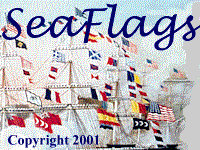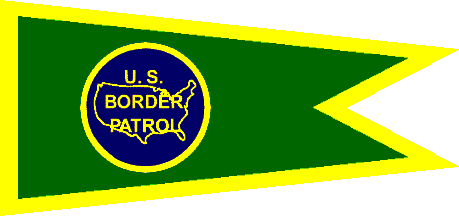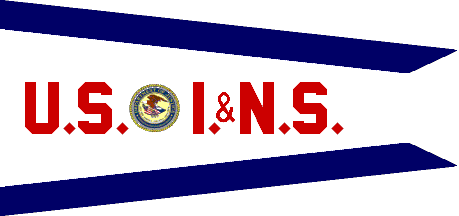
 |
Other Federal Maritime Agencies |
On this page:
The U.S. Customs ensign originated in the practice, adopted by collectors of customs in the 19th century, of flying at their customs houses the flag originally adopted in 1799 to identify revenue cutters at sea. (For the history of this flag, see U.S. Coast Guard.) This practice was officially approved in 1874 by Secretary of the Treasury William Richardson, who directed that what was then known as the revenue ensign be hoisted alongside the national flag outside all customs houses during business hours. In 1910, President Taft directed that the flag used by the Revenue Cutter Service be distinguished from that flown ashore by the addition of the RCS badge on the fly. In 1915, the U.S. Coast Guard was established as a bureau separate from the Bureau of Customs, inheriting the RCS ensign, while the original flag without the badge was retained by the Bureau of Customs. The most recent change to the Customs ensign was the 1951 redesign of the national coat of arms to conform to the rendering on the great seal of the United States.
The Customs Service originated in the authority, enacted by the very first Congress, to establish collectors of customs at the various ports of the United States. The management of these collectors was subsequently vested in the Bureau of Customs of the Department of the Treasury, renamed the U.S. Customs Service in 1973. The old Customs Service was moved to the new Department of Homeland Security under the Homeland Security Act of 2002, which divided customs functions into two new bureaus, Immigration and Customs Enforcement (ICE), and Customs and Border Protection (CBP).
The Customs ensign is displayed along with the national flag above and inside CBP facilities as well as aboard the substantial number of harbor and inshore patrol boats operated by the bureau.

The Border Patrol was established in 1924 as an enforcement arm of the Immigration and Naturalization Service, responsible for protecting against entry into the United States other than at the lawful ports of entry. Along with land-based units, it operates a fleet of some 55 vessels in United States and Puerto Rican coastal waters and rivers and on the Great Lakes and other interior waterways shared by the United States and Canada. The pennant, which flies aboard Border Patrol vessels and over its installations, was created in connection with the organization's 75th anniversary in 1999. Like other elements of INS, the Border Patrol is moved to the new Department of Homeland Security under the Homeland Security Act of 2002, where it was subordinated to the Bureau of Customs and Border Protection. However, it maintains its own service identify within CBP and continues to fly this pennant.
In addition, a similar flag in a rectangular format exists for interior display, on which the central device is surrounded by a ring of stars symbolizing the sectors and other units of the Border Patrol.

The INS traced its history to the Immigration Act of 1891, which created a Bureau of Immigration within the Department of the Treasury to enforce the laws regulating the massive inflow of immigrants from Europe during this period. It was moved to the newly created Department of Commerce and Labor in 1903 and became the Bureau of Immigration and Naturalization after the passage of the Naturalization Act of 1906. These two functions were split in 1913 but merged again under the Immigration and Naturalization Service in 1933. The service was moved from the Labor Department to the Justice Department in 1940, as the primary concern about aliens in the United States had become one of national security rather than labor and employment. The service remained in Justice until the passage of the Homeland Security Act of 2002, which abolished INS and moves its functions, including enforcing the nation's entry laws and regulations through inspections at ports of entry, including seaports, to the new Department of Homeland Security. It appears that this pennant disappeared with the reorganization.

The flag of the Department of the Interior is divided by two diagonal lines, light blue in the upper and lower quadrants and white in the hoist and fly, with the departmental seal in color on the center. The seal depicts a bison standing on a prairie before a mountain range. Although primarily for display ashore, departmental regulations provide for a 22 by 32 inch version to be flown in boats of the department.
The U.S. Geological Survey is a bureau of the Department of the Interior which, among other things, operates a small fleet of research vessels on both coasts and the Great Lakes. These ships conduct geophysical, limnological, biological, and mineralogical research. The USGS flag, adopted in 1906, comes in two sizes, two by three feet for display from halyards (as shown) and 52 by 66 inch (with fringe, cord, and tassels) for indoor and ceremonial use.
The U.S. Fish and Wildlife Service is a bureau of the Department of the Interior established in 1939 by merging the Department of Agriculture's Bureau of Biological Survey and the Department of Commerce's Bureau of Fisheries. The USFWS administers a series of national wildlife refuges and ensures compliance with federal laws protecting migratory birds, fish, and other wildlife. In the latter capacity, USFWS inspectors are present at U.S. ports of entry to enforce laws against smuggling of endangered and threatened species of wildlife. Starting in 1940, the service used a flag divided diagonally, dark blue and white, with the silhouettes of a flying Canada goose and a jumping trout. Unfortunately, this attractive and distinctive design has since been replaced with an uninspired design featuring a cluttered seal and a great deal of writing on a plain white background.

The Saint Lawrence Seaway Development Corporation, an agency of the Department of Transportation, was created in 1954 to construct, operate, and maintain the portions of the binational U.s.-Canadian Saint Lawrence Seaway located within U.S. territory. Its Canadian counterpart is the Saint Lawrence Seaway Management Corporation. The corporation flag, showing a silver trident between a gold eagle (representing the United States) and a gold maple leave (representing Canada), was designed by the U.S. Army's Heraldic Services Division (now The Institute of Heraldry) and approved by the corporation in 1959.
The Environmental
Protection Agency operates two major research vessels, the 250-ton OSV
Peter
W. Anderson in the Atlantic and the 266-ton RV Lake Guardian
on the Great Lakes, as well as a number of smaller research vessels and
boats. The EPA flag is white with the agency seal on the center and
is occasionally flown by vessels of the EPA fleet.
Return to top of page
The Smithsonian
Institution, best known as the parent organization of the U.S. national
museums on the Mall in Washington, is also a premier scientific research
institution. It operates a number of maritime-related research centers,
including the Smithsonian Tropical Research Institute in Panama, the Smithsonian
Marine Station in Fort Pierce, Florida, and the Smithsonian Environmental
Research Center in Edgewater, Maryland, on the Chesapeake Bay. Each
of these centers operates a number of small to medium-size research vessels.
The Institution flag is displayed at Smithsonian facilities from the headquarters
at "The Castle" in Washington to outlying field activities.
Return to top of page
The Tennessee Valley Authority was created in 1933 as a project to control the devastating seasonal floods of the Tennessee River and its tributaries and to generate hydroelectric power to meets the underdeveloped region's energy needs. Its navigational responsibilities include the maintenance of a nine-foot channel on the Tennessee River from Paducah, Kentucky, to Knoxville, Tennessee, as well as the operation of a sprawling network of locks and dams. It is also the principal electric power provider to most of Tennessee, large portions of Kentucky, Mississippi, and Alabama, and smaller areas of Georgia and North Carolina. Its flag can be seen on many of its installations.